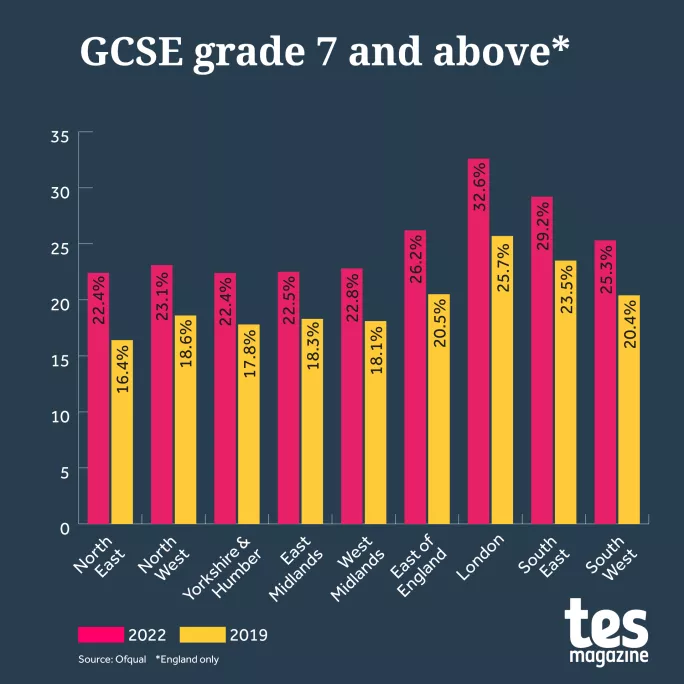An attainment gap between regions in the North and South of England in the proportion of GCSE exam entries achieving top grades has widened since exams were last held before the Covid pandemic.
The gap between the North East and Yorkshire and the Humber, which both received the lowest proportion of GCSE grades at 7/A or above out of all the regions (22.4 per cent), and London, which received the highest proportion (32.6 per cent), was 10.2 percentage points this year.
Find out about GCSE results day 2023
This is a small increase in the attainment gap between the highest- and lowest-performing regions when GCSE exams were last held in 2019, which was 9.3 percentage points.
In 2019, the North East was also the lowest-performing region and London was the highest-performing region.
The slight increase in the regional attainment gap could reflect the variation in school Covid absence between the North and South of England.
GCSE results: regional gap could reflect Covid absence
Analysis by FFT Education Datalab shows that the North East and Yorkshire and the Humber had the highest Covid absence rates across Years 10 and 11 at state schools this year, with rates over 14 per cent.
London had the lowest absence rates among these year groups: below 12 per cent.
FFT warned earlier this week that this “will translate into differences in grades on Thursday”.
Early research into the impact of the pandemic on learning loss also revealed a regional disparity back in October 2021.
This Department for Education research showed that parts of the North were hardest hit in both reading and maths.
Regional differences in learning loss had previously been considered in late 2020 as a reason to adjust exam grading for GCSEs and A levels by area, although this was later ruled out.
Jon Andrews, head of analysis at the Education Policy Institute (EPI) think tank, said today’s GCSE results showed the “continuing divide in the attainment levels between different areas of England”.
He added: “While it’s unclear the extent to which this is a continuation of long-term trends of regional disparities, our research has previously highlighted education in the North and the Midlands to have been, on average, more severely impacted by the pandemic than in other parts of the country.
“It’s clear the government must do more to combat geographic inequalities in educational outcomes.”
A breakdown of results by region
Figures published today give a breakdown of the proportion of GCSE entries graded at 7/A or above in each government region of England.
The figures can be seen in the graphic below.
London saw the highest proportion of top grades, followed by the South East.
The regional disparity has followed a similar trend to previous years, with the North East or Yorkshire and the Humber receiving the lowest proportion of top grades each year since 2019.
In 2021, when teacher-assessed grades were used to determine GCSE results, the regional divide was similar. London - the highest-performing region - saw 34.5 per cent of students awarded a 7 or above, while in Yorkshire and the Humber - the lowest-performing region - the equivalent figure was 24.4 per cent.
The attainment gap between regions in the North and South of England in terms of the proportion of A-level exam entries achieving top grades widened more significantly than at GCSE between 2019 and 2022.
Last week’s A-level results show that the gap between the North East, which received the lowest proportion of A-level A* and A grades out of all the regions (30.8 per cent), and the South East, which received the highest proportion (39.5 per cent), was 8.7 percentage points this year. Whereas in 2019, the gap between the lowest- and highest-performing regions was just 5.3 percentage points.





